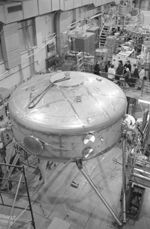A massive vessel reminiscent of a spaceship, complete with silver dome and legs, was one of the more startling stops on a Plasma Science and Fusion Center tour last week.
The tour, part of the center's IAP Open House, allowed visitors to see for themselves some of the experiments PSFC researchers are conducting to understand electrically charged gases -- plasmas -- and their application to producing power by nuclear fusion. When confined, some plasma nuclei fuse, releasing energy.
The "spaceship," for example, is key to the Levitated Dipole Experiment, or LDX. It's a new approach to nuclear fusion in which MIT and Columbia University scientists hope to magnetically levitate a superconducting ring about three feet in diameter in a vacuum chamber about 16 feet in diameter (the "spaceship"). Plasma will then be confined by following magnetic fields that encircle the floating ring.
Darren Garnier, a PSFC visiting scientist from Columbia, said the superconducting ring should be completed this fall. The researchers hope to create a plasma in the vessel about a year from now.
The open house also included a talk and tour about Alcator C-Mod, the PSFC's principal experiment on nuclear fusion. In Alcator C-Mod, the plasma is confined in a doughnut shape via magnetic fields. The machine itself isn't currently visible, since it's encased in a giant "thermos" for cooling with liquid nitrogen. However, people on the Alcator C-Mod tour led by Yongkyoon In, a graduate student in nuclear engineering, could view some of the more than 20 diagnostic instruments extending from the machine.
MIT researchers are now upgrading these instruments, which measure such things as temperature and current density. In a talk earlier in the day, PSFC Research Scientist John Rice noted how new diagnostics have shown that there is a very steep gradient of plasma parameters near the edge of the plasma. For example, the researchers found that the electron temperature drops by a factor of 10 over just two centimeters.
A version of this article appeared in MIT Tech Talk on January 26, 2000.






